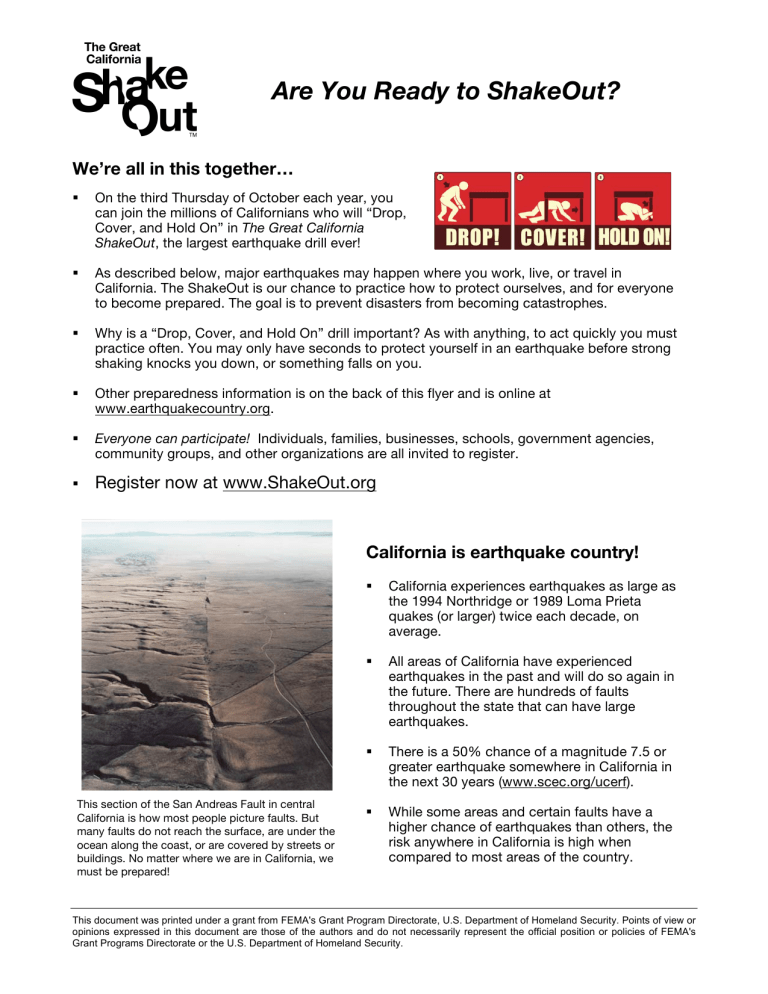Are You Ready to ShakeOut? We’re all in this together…

Are You Ready to ShakeOut?
We’re all in this together…
On the third Thursday of October each year, you can join the millions of Californians who will “Drop,
Cover, and Hold On” in The Great California
ShakeOut , the largest earthquake drill ever!
As described below, major earthquakes may happen where you work, live, or travel in
California. The ShakeOut is our chance to practice how to protect ourselves, and for everyone to become prepared. The goal is to prevent disasters from becoming catastrophes.
Why is a “Drop, Cover, and Hold On” drill important? As with anything, to act quickly you must practice often. You may only have seconds to protect yourself in an earthquake before strong shaking knocks you down, or something falls on you.
Other preparedness information is on the back of this flyer and is online at www.earthquakecountry.org.
Everyone can participate!
Individuals, families, businesses, schools, government agencies, community groups, and other organizations are all invited to register.
Register now at www.ShakeOut.org
This section of the San Andreas Fault in central
California is how most people picture faults. But many faults do not reach the surface, are under the ocean along the coast, or are covered by streets or buildings. No matter where we are in California, we must be prepared!
California is earthquake country!
California experiences earthquakes as large as the 1994 Northridge or 1989 Loma Prieta quakes (or larger) twice each decade, on average.
All areas of California have experienced earthquakes in the past and will do so again in the future. There are hundreds of faults throughout the state that can have large earthquakes.
There is a 50% chance of a magnitude 7.5 or greater earthquake somewhere in California in the next 30 years (www.scec.org/ucerf).
While some areas and certain faults have a higher chance of earthquakes than others, the risk anywhere in California is high when compared to most areas of the country.
This document was printed under a grant from FEMA's Grant Program Directorate, U.S. Department of Homeland Security. Points of view or opinions expressed in this document are those of the authors and do not necessarily represent the official position or policies of FEMA's
Grant Programs Directorate or the U.S. Department of Homeland Security.
The Seven Steps to Earthquake Safety
From Putting Down Roots in Earthquake Country , available at www.earthquakecountry.org
PREPARE
1.
Identify earthquake hazards in your home, and check if you are in a tsunami hazard zone:
You should secure anything heavy enough to hurt you if it falls on you, or anything that will be a significant loss if it breaks. Move heavy objects to lower locations, strap your water heater and top heavy furniture to walls, and securing electronics and valuables to tables. Do you live, work, or travel near the coast? Find out what areas are at risk of a tsunami.
2.
Create a disaster plan: Plan now what each person in your household will do before, during and after an earthquake. Have a meeting place and an out-of-state contact. Learn basic first aid. Plan how to deal with the risk of fire, potential lack of utilities and basic services, and aftershocks. For those with functional or mobility needs, identify people who can assist you where you regularly spend time. Learn the natural and official warnings of a tsunami and know how to respond.
3.
Create disaster supplies kits: Everyone should have personal disaster supplies kits, which are useful for many emergencies. Keep one kit in your home, one in your car, and a third at work. Your home should have a larger household kit with supplies to last three days to one week.
4. Identify and fix your building’s weaknesses: There are several common issues that can limit a building's ability to withstand earthquake shaking, such as inadequate foundations, unbraced cripple walls, soft first stories and unreinforced masonry. Seek professional retrofitting advice if your building has these issues.
PROTECT
5. During earthquakes–Drop, cover and hold on: Drop to the floor, take cover under a sturdy desk or table, and hold on to it firmly. If no table is nearby, drop to the floor near an interior wall and cover your head and neck with your arms and hands. Face away from windows or mirrors. Do not leave a building during an earthquake. If you use a wheelchair or have other mobility impairments, protect your head and neck with a pillow or your arms if you are able. Learn more at www.dropcoverholdon.org, including what to do in different situations. Everyone can practice what to do during earthquakes in the Great California ShakeOut (www.ShakeOut.org).
RECOVER
6. After earthquakes–Check for injuries and damage: Remain calm and take care of yourself first. If you live on the coast in a tsunami inundation zone, immediately walk to higher ground or inland away from the coast. If you are in a safe area, help others and check for damage. Learn in advance what to do about fire, leaking gas, electrical dangers, and chemical spills. Aftershocks may cause additional damage so be ready to drop, cover, and hold on.
7. When safe, continue to follow your disaster plan: If you evacuated coastal areas - stay away until officials permit you to return. When possible, if you cannot stay in your home, take your disaster kit and get to a safe location. Listen to a portable radio for news, and call your out-of-state contact. Begin your recovery by organizing your financial papers and documenting any damage.
The Earthquake Country Alliance is a statewide partnership of earthquake experts, emergency managers, business and community leaders, and others working to help
Californians prepare for earthquakes. Visit www.earthquakecountry.org/alliance.
The California Emergency Management Agency is a proud leader and partner in the
Earthquake Country Alliance. Learn more about disaster readiness, and about
CalEMA’s programs and responsibilities at www.calema.ca.gov.







